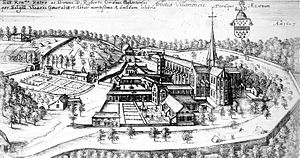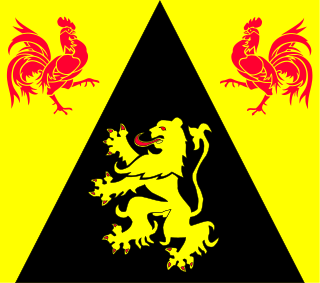
Walloon Brabant is a province located in Belgium's French-speaking region of Wallonia. It borders on the province of Flemish Brabant and the provinces of Liège, Namur and Hainaut. Walloon Brabant's capital and largest city is Wavre.

Villers-la-Ville is a municipality of Wallonia located in the Belgian province of Walloon Brabant. On January 1, 2006, Villers-la-Ville had a total population of 9,572. The total area is 47.45 km2 which gives a population density of 202 inhabitants per km2. The municipality includes also the villages of Marbais, Mellery, Sart-Dames-Avelines and Tilly.

Alice of Schaerbeek, was a Cistercian laysister who is venerated as the patron saint of the blind and paralyzed. Her feast day is 15 June.

La Cambre Abbey or Ter Kameren Abbey is a former Cistercian abbey in the City of Brussels, Belgium. It is located in the Maelbeek valley between the Bois de la Cambre/Ter Kamerenbos and the Ixelles Ponds. The abbey church is a Catholic parish of the Archdiocese of Mechelen–Brussels and home to a community of Norbertine canons, while other parts of the monastery house the headquarters of the Belgian National Geographic Institute (NGI) and La Cambre, a prestigious visual arts school.
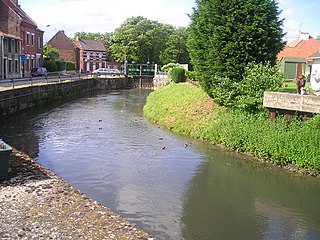
La Gorgue is a town in northern France. It is a commune in the Nord department. The population of La Gorgue in 2019 was 5,639.

Vaux-de-Cernay Abbey is a former Cistercian monastery in northern France (Île-de-France), situated in Cernay-la-Ville, in the Diocese of Versailles, Yvelines. The abbey was abandoned during the French Revolution and fell into partial ruin. Most of the buildings, except for the church, were restored in the late 19th century by Charlotte de Rothschild, and the property is now a hotel.

Dieleghem Abbey or Dielegem Abbey is a former abbey located in the Brussels municipality of Jette, Belgium. It was abolished in 1796.

Cambron Abbey was a Cistercian abbey in Cambron-Casteau, in the municipality of Brugelette, Hainaut, Belgium. It was located on the river Blanche, a tributary of the Dender, about 9 km (5.6 mi) to the south-east of Ath. Dissolved in 1782, parts of the abbey still survive as ruins within Pairi Daiza zoo and botanical garden.

Nizelles Abbey was an abbey of Cistercian monks located in Wallonia in Ophain-Bois-Seigneur-Isaac in Braine-l'Alleud, Walloon Brabant, Belgium, on a short distance to the south of Brussels.
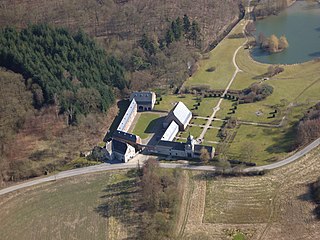
Grandpré Abbey is a former Cistercian abbey located at Faulx-les-Tombes, in the province of Namur, Wallonia, Belgium. The only remains of the abbey are the gatehouse and the attached range at the main entrance, the farm buildings and the mill, once powered by the Samson brook, which crosses the site.
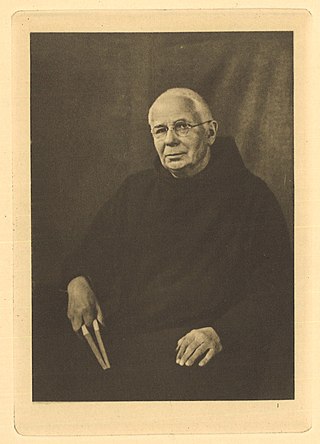
Ursmer Berlière, born Alfred Berlière (1861–1932) was a monk of Maredsous Abbey and a monastic historian whose bibliography ran to 360 publications.

Cadouin Abbey was a Cistercian monastery founded as a hermitage in 1115 by Gerald of Salles, in the name of Robert of Arbrissel, in what is now the commune of Le Buisson-de-Cadouin in the Dordogne, south-west France.
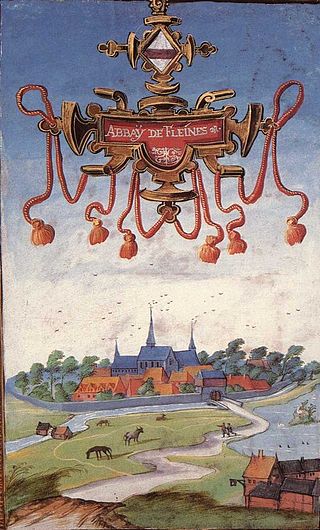
Flines Abbey was a Cistercian nunnery in Flines-lez-Raches near Douai, in the Nord department of France. It was founded in about 1234 by Countess Margaret of Flanders, and served as the burial place not only of Margaret in 1278 but of Margaret's husband William II of Dampierre and their son Guy, Count of Flanders (1304), as well as of Guy's wives Matilda of Béthune (1263) and Isabelle of Luxembourg (1298).

Dalon Abbey is a former Cistercian monastery in Sainte-Trie, Dordogne, southwestern France. It is listed as a Historic Monument.

The Abbaye de la Fille-Dieu is a Cistercian monastery located near the town of Romont in the Swiss Canton of Fribourg. Founded as a Benedictine priory in 1268, and continuously occupied by a community of nuns since its establishment, the alpine abbey is a Swiss heritage site of national significance. Heavily altered through its history, Fille-Dieu was restructured by economic turmoil, fire, additions and unsympathetic alterations. In 1906 the abbey became affiliated with the Trappists, and between 1990 and 1996 an internationally notable restoration was undertaken, modernising the monastic buildings, restoring the abbey church to its original volume, and preserving its rediscovered medieval murals, with the only contemporary element a suite of stained glass windows commissioned from the British artist Brian Clarke. Further restoration of the abbey continues today.

Les Écharlis Abbey is a former Cistercian monastery in Villefranche, Yonne, France. It was founded in the 12th century by a secular priest with two companions who wanted to live a monastic life. Soon afterward, the monastery joined the Cistercian order as a dependency of Fontenay Abbey.
Laurent Servais Duriau, known as Servais, was a Cistercian monk from the Abbey of Val-Dieu. An encyclopedist, he catalogued vast numbers of engravings.

Beaugerais Abbey is a former Cistercian abbey, located in what is now the commune of Loché-sur-Indrois, in the Indre-et-Loire département of France.


